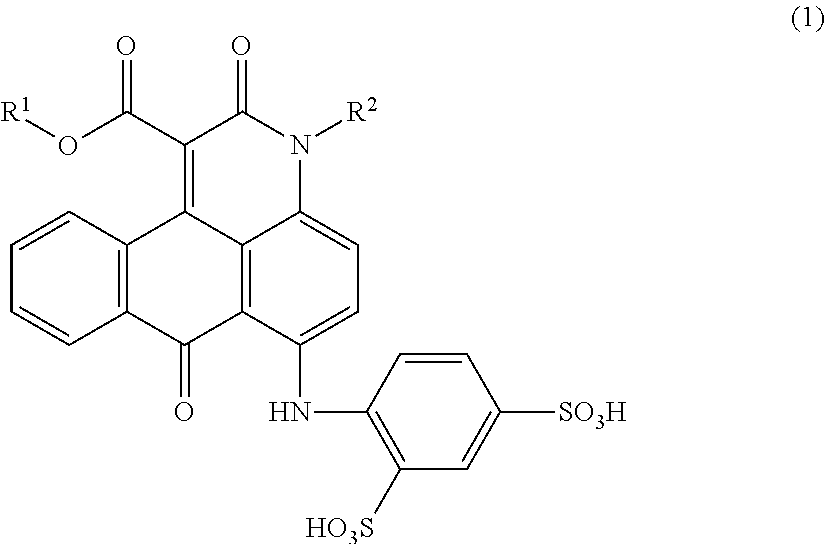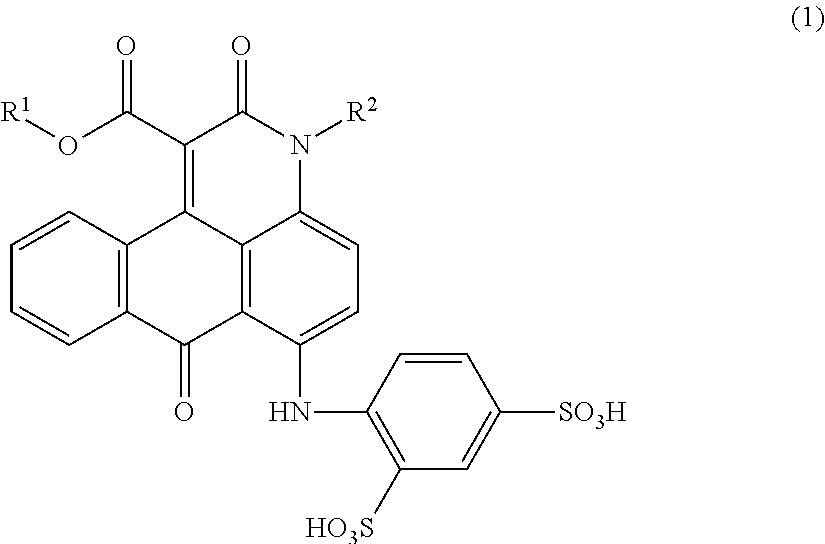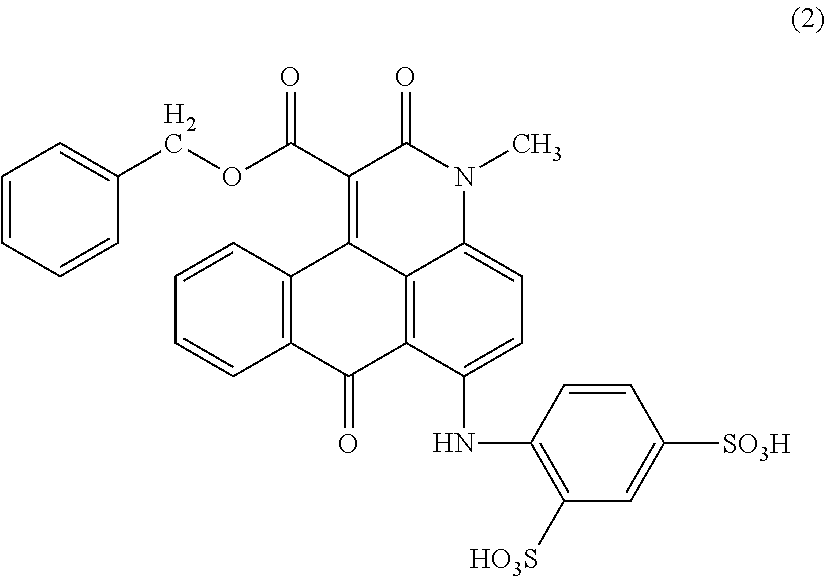Anthrapyridone compound, salt thereof, magenta ink composition and colored product
a technology of anthrapyridone and compound, which is applied in the direction of benz-azabenzanthrone dye, instruments, transportation and packaging, etc., can solve the problems of discoloration or fading of printed images, improvement of ozone gas fastness, and inability to establish a large improvement technique, etc., to achieve good filtration properties, excellent water-solubility, and vivid hue
- Summary
- Abstract
- Description
- Claims
- Application Information
AI Technical Summary
Benefits of technology
Problems solved by technology
Method used
Image
Examples
synthesis example 1
[0088]According to the example 1-1 of Patent Literature 1, 24.6 parts of 1-methylamino-4-anilinoanthraquinone, 0.75 parts of sodium carbonate, 30.0 parts of diethylmalonate and 75 parts of o-dichlorobenzene were placed in a reactor, heated to 170 to 175° C., and reacted for 10 hours. In the meantime, the reaction was carried out while removing ethanol and water produced as the reaction proceeded, out of the reaction system.
[0089]The reaction liquid was cooled, and 150 parts of methanol was added thereto and stirred for 1 hour to precipitate a solid, which was then separated by filtration. The resulting solid was washed with 100 parts of methanol followed by 300 parts of hot water, and dried to obtain 25.2 parts of a compound represented by the following formula (4).
[0090]
example 1
(1) Under water-cooling, 57.8 parts of 31% fuming sulfuric acid was added to 292.2 parts of 96% sulfuric acid at 40° C. or below so as to prepare 12% fuming sulfuric acid.
[0091]After 106.0 parts of a compound of the above formula (4) was added to the obtained fuming sulfuric acid at 70° C. or below over 30 minutes, the reaction liquid was raised in temperature to 80 to 90° C. and the reaction was carried out at this temperature for 2 hours. After cooling to 40° C., the reaction liquid was added to 1800 parts of ice water and stirred at room temperature for 30 minutes. After the resulting solution was filtered to remove off insoluble substances, water was added to the filtrate to adjust the volume to 2000 parts, 300 parts of sodium chloride was further added and stirring was carried out for 1.5 hours. The resulting precipitated solid was separated by filtration and washed with 500 parts of a 20% aqueous sodium chloride solution to obtain 210 parts of a dark red cake.
[0092](2) After t...
example 2
[0097]To 45 parts of water, 9.0 parts of the compound of the above formula (5) obtained in Example 1 (2) was added, and a 25% aqueous sodium hydroxide solution was added thereto under stirring to adjust the pH to 5.6 and then heated to 70° C. to obtain a solution. To the obtained solution, 6.6 parts of 1-(chloromethyl)naphthalene was added dropwise over 27 minutes while maintaining at 70 to 75° C. and pH 5.2. Subsequently, the reaction was carried out for 1.5 hours while maintaining the same temperature and pH. After cooling the reaction liquid to 27° C., 60 parts of methanol was added thereto and stirred at room temperature for 2 hours. The resulting precipitated solid was separated by filtration, washed with 100 parts of methanol, and then dried to obtain 5.2 parts of a compound of the following formula (6) as red crystals. λmax: 535.4 nm.
[0098]
PUM
| Property | Measurement | Unit |
|---|---|---|
| temperature | aaaaa | aaaaa |
| temperature | aaaaa | aaaaa |
| pore size | aaaaa | aaaaa |
Abstract
Description
Claims
Application Information
 Login to View More
Login to View More - R&D
- Intellectual Property
- Life Sciences
- Materials
- Tech Scout
- Unparalleled Data Quality
- Higher Quality Content
- 60% Fewer Hallucinations
Browse by: Latest US Patents, China's latest patents, Technical Efficacy Thesaurus, Application Domain, Technology Topic, Popular Technical Reports.
© 2025 PatSnap. All rights reserved.Legal|Privacy policy|Modern Slavery Act Transparency Statement|Sitemap|About US| Contact US: help@patsnap.com



